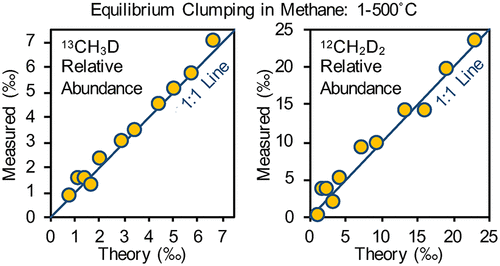当前位置:
X-MOL 学术
›
ACS Earth Space Chem.
›
论文详情
Our official English website, www.x-mol.net, welcomes your feedback! (Note: you will need to create a separate account there.)
Comparison of Experimental vs Theoretical Abundances of 13CH3D and 12CH2D2 for Isotopically Equilibrated Systems from 1 to 500 °C
ACS Earth and Space Chemistry ( IF 3.4 ) Pub Date : 2019-11-22 , DOI: 10.1021/acsearthspacechem.9b00244 Daniel L. Eldridge 1, 2 , Roman Korol 3 , Max K. Lloyd 2 , Andrew C. Turner 2 , Michael A. Webb 4 , Thomas F. Miller 3 , Daniel A. Stolper 1, 2
ACS Earth and Space Chemistry ( IF 3.4 ) Pub Date : 2019-11-22 , DOI: 10.1021/acsearthspacechem.9b00244 Daniel L. Eldridge 1, 2 , Roman Korol 3 , Max K. Lloyd 2 , Andrew C. Turner 2 , Michael A. Webb 4 , Thomas F. Miller 3 , Daniel A. Stolper 1, 2
Affiliation

|
Methane is produced and consumed via numerous microbial and chemical reactions in atmospheric, hydrothermal, and magmatic reactions. The stable isotopic composition of methane has been used extensively for decades to constrain the source of methane in the environment. A recently introduced isotopic parameter used to study the formation temperature and formational conditions of methane is the measurement of molecules of methane with multiple rare, heavy isotopes (“clumped”) such as 13CH3D and 12CH2D2. In order to place methane-clumped isotope measurements into a thermodynamic reference frame that allows calculations of clumped isotope-based temperatures (geothermometry) and comparison between laboratories, all past studies have calibrated their measurements using a combination of experiment and theory based on the temperature dependence of clumped isotopologue distributions for isotopically equilibrated systems. These have previously been performed at relatively high temperatures (>150 °C). Given that many natural occurrences of methane form below these temperatures, previous calibrations require extrapolation when calculating clumped isotope-based temperatures outside of this calibration range. We provide a new experimental calibration of the relative equilibrium abundances of 13CH3D and 12CH2D2 from 1 to 500 °C using a combination of γ-Al2O3- and Ni-based catalysts and compare them to new theoretical computations using Path Integral Monte Carlo (PIMC) methods and find 1:1 agreement (within ±1 standard error) for the observed temperature dependence of clumping between experiment and theory over this range. This demonstrates that measurements, experiments, and theory agree from 1 to 500 °C, providing confidence in the overall approaches. Polynomial fits to PIMC computations, which are considered the most rigorous theoretical approach available, are given as follows (valid T ≥ 270 K): Δ13CH3D ≅ 1000 × ln(K13CH3D) = (1.47348 × 1019)/T7 – (2.08648 × 1017)/T6 + (1.19810 × 1015)/T5 – (3.54757 × 1012)/T4 + (5.54476 × 109)/T3 – (3.49294 × 106)/T2 + (8.89370 × 102)/T and Δ12CH2D2 ≅ 1000 × ln(8/3K12CH2D2) = −(9.67634 × 1015)/T6 + (1.71917 × 1014)/T5 – (1.24819 × 1012)/T4 + (4.30283 × 109)/T3 – (4.48660 × 106)/T2 + (1.86258 × 103)/T. We additionally compare PIMC computations to those performed utilizing traditional approaches that are the basis of most previous calibrations (Bigeleisen, Mayer, and Urey model, BMU) and discuss the potential sources of error in the BMU model relative to PIMC computations.
中文翻译:

1至500°C同位素平衡系统的13 CH 3 D和12 CH 2 D 2的实验丰度和理论丰度的比较
甲烷是通过大气,水热和岩浆反应中的多种微生物和化学反应产生和消耗的。甲烷的稳定同位素组成已被广泛使用了数十年,以限制环境中甲烷的来源。最近用于研究甲烷的形成温度和形成条件的同位素参数是测量具有多种稀有,重同位素(“团块”)(例如13 CH 3 D和12 CH 2 D 2)的甲烷分子。为了将甲烷凝结的同位素测量值放入热力学参考系中,以计算基于凝结的同位素温度(地热法)并在实验室之间进行比较,所有过去的研究都结合了基于温度依赖性的实验和理论,对它们的测量值进行了校准。同位素平衡系统的成簇同位素同位素分布图。这些操作以前是在相对较高的温度(> 150°C)下进行的。鉴于在这些温度以下会形成许多自然发生的甲烷,因此在计算超出此校准范围的基于同位素的成簇温度时,以前的校准需要外推。我们提供了13 CH 3相对平衡丰度的新实验校准d和12 CH 2 d 2从1至500℃下使用的组合的γ-Al 2 ö 3 -和Ni基催化剂和使用路径积分蒙特卡洛(PIMC)方法比较它们新的理论计算和找到1:1在此范围内观察到的实验和理论之间的结块温度相关性(在±1个标准误差内)一致。这表明在1至500°C的温度范围内,测量值,实验值和理论值都一致,从而为总体方法提供了信心。多项式拟合到PIMC计算,这被认为是最严格的理论方法可用,如下给出(有效Ť ≥270 K):Δ 13 CH 3 d≅1000×ln(K 13 CH 3 D)=(1.47348×10 19)/ T 7 –(2.08648×10 17)/ T 6 +(1.19810×10 15)/ T 5 –(3.54757×10 12)/ T 4 +(5.54476×10 9)/ Ť 3 - (3.49294×10 6)/ Ť 2 +(8.89370×10 2)/ Ť和Δ 12 CH 2 d 2 ≅1000×LN(8/3 ķ 12 CH2 D 2)= −(9.67634×10 15)/ T 6 +(1.71917×10 14)/ T 5 –(1.24819×10 12)/ T 4 +(4.30283×10 9)/ T 3 –(4.48660×10 6)/ Ť 2 +(1.86258×10 3)/ Ť。我们还将PIMC计算与使用传统方法进行的计算进行比较,而传统方法是大多数先前校准的基础(Bigeleisen,Mayer和Urey模型,BMU),并讨论了相对于PIMC计算的BMU模型中潜在的误差源。
更新日期:2019-11-22
中文翻译:

1至500°C同位素平衡系统的13 CH 3 D和12 CH 2 D 2的实验丰度和理论丰度的比较
甲烷是通过大气,水热和岩浆反应中的多种微生物和化学反应产生和消耗的。甲烷的稳定同位素组成已被广泛使用了数十年,以限制环境中甲烷的来源。最近用于研究甲烷的形成温度和形成条件的同位素参数是测量具有多种稀有,重同位素(“团块”)(例如13 CH 3 D和12 CH 2 D 2)的甲烷分子。为了将甲烷凝结的同位素测量值放入热力学参考系中,以计算基于凝结的同位素温度(地热法)并在实验室之间进行比较,所有过去的研究都结合了基于温度依赖性的实验和理论,对它们的测量值进行了校准。同位素平衡系统的成簇同位素同位素分布图。这些操作以前是在相对较高的温度(> 150°C)下进行的。鉴于在这些温度以下会形成许多自然发生的甲烷,因此在计算超出此校准范围的基于同位素的成簇温度时,以前的校准需要外推。我们提供了13 CH 3相对平衡丰度的新实验校准d和12 CH 2 d 2从1至500℃下使用的组合的γ-Al 2 ö 3 -和Ni基催化剂和使用路径积分蒙特卡洛(PIMC)方法比较它们新的理论计算和找到1:1在此范围内观察到的实验和理论之间的结块温度相关性(在±1个标准误差内)一致。这表明在1至500°C的温度范围内,测量值,实验值和理论值都一致,从而为总体方法提供了信心。多项式拟合到PIMC计算,这被认为是最严格的理论方法可用,如下给出(有效Ť ≥270 K):Δ 13 CH 3 d≅1000×ln(K 13 CH 3 D)=(1.47348×10 19)/ T 7 –(2.08648×10 17)/ T 6 +(1.19810×10 15)/ T 5 –(3.54757×10 12)/ T 4 +(5.54476×10 9)/ Ť 3 - (3.49294×10 6)/ Ť 2 +(8.89370×10 2)/ Ť和Δ 12 CH 2 d 2 ≅1000×LN(8/3 ķ 12 CH2 D 2)= −(9.67634×10 15)/ T 6 +(1.71917×10 14)/ T 5 –(1.24819×10 12)/ T 4 +(4.30283×10 9)/ T 3 –(4.48660×10 6)/ Ť 2 +(1.86258×10 3)/ Ť。我们还将PIMC计算与使用传统方法进行的计算进行比较,而传统方法是大多数先前校准的基础(Bigeleisen,Mayer和Urey模型,BMU),并讨论了相对于PIMC计算的BMU模型中潜在的误差源。


























 京公网安备 11010802027423号
京公网安备 11010802027423号